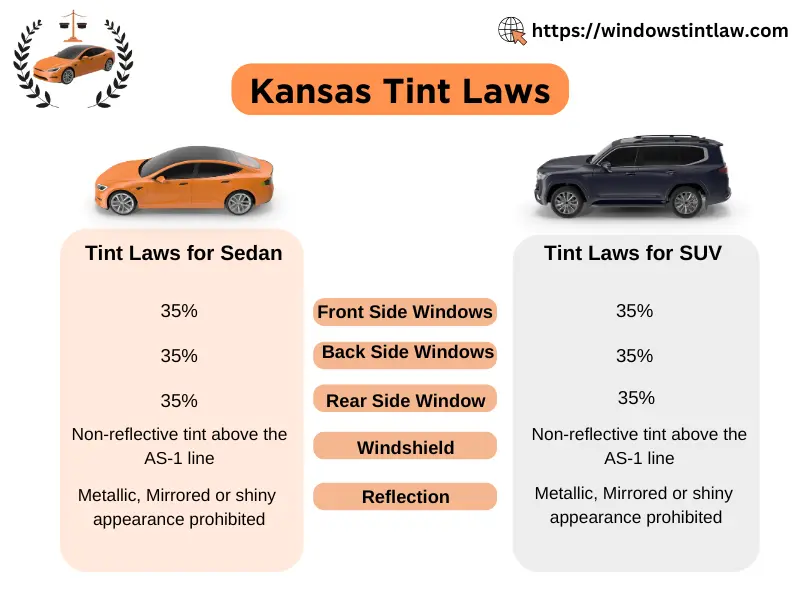Kansas tint laws were legislated in 1987 for the safety of drivers and passengers on road.
According to Uniform Act Regulating Traffic Equipment of Vehicles, No person shall drive motor vehicle with damaged front windshield, side or rear window which obscures the driver’s vision. Also no individual shall drive the motor vehicle with any sign, poster or sticker applied to front windshield which impairs the clear vision of highway for the driver.
Tinted windows are beneficial as they block harmful ultraviolet rays emitted from the sun but following the state rules is mandatory to avoid tint tickets and legal actions from the state departments.
Overview of Kansas Tint Laws
The below infographic shows the legal tint limits for Cars and SUVs operated and registered in Kansas. We advise motorists to follow these rules to avoid getting pulled over by the police.

Darkest Legal Tint in Kansas
The darkest legal tint limits for Cars and SUVs operated in Kansas are provided as below:
| State | Front Side Windows | Back Side Windows | Rear Window | Windshield | Tint Reflection | Tint color Restrictions |
| Kansas | 35% | 35% | 35% | Non-reflective tint above the AS-1 line. | Metallic, Mirror-like and shiny tint prohibited. | Red, Amber and Yellow tint colors are restricted. |
The side windows and rear window must have 35% or more VLT percentage, lower than 35% tint shall be considered as illegal.
Window Tint Reflection
The front side windows, back side windows and rear window should not produce mirror-like effect or windows must not look shiny or metallic in appearance. The same rule is applicable for Sedan Cars and SUVs or MPVs.
The metallic or shiny tint or coating materials produce glare effect due to sunlight. The glare produced due to metallic or mirror-like tinting materials causes inconvenience for other drivers on the highways.
Hence, Motorists must apply or affix the type of window tinting material which should have minimum solar reflectance.
Other Rules & Regulations
Besides the tint darkness and reflections, there are some other rules to be followed by drivers and vehicle owners:
- Dual Side Mirrors: Dual side mirrors are required if the rear window of vehicle is tinted.
- Restricted Tint Colors: Kansas Highway Patrol may pull over the vehicle with Red, Amber and Yellow tint colors. These colors are restricted by the law.
- Certificates: Window Film manufacturers do not need to get certification for the tinting materials they sell in the state.
- Sticker or Label: Kansas window tinting rules recommend to apply label on windows to identify the legal tint.
Medical Exemption
Window Tinting laws of Kansas do not permit to install lower tint on windows due to medical conditions. So, Medical exemption certificates are not granted by the Kansas Department of Transportation.
Check out the window tinting laws of other US states to determine which states grants medical exemption certificates.
Penalties for Violating Tint Laws
Any person who install illegal window tints in Kansas shall be guilty of “Class C” Misdemeanor. Tint tickets shall be issued to the driver and repeated violations may cost higher amount of fines and may requires the driver to appear in the court. Hence, it is not worthy to install lower tints, as the tint limits in the state are already relatively lower as compared to other US states.
Further, It is recommended to test your window tints while installations to make sure the coating materials must have VLT of 35% or higher. Professional window film installers have an electronic device to test window tint.
